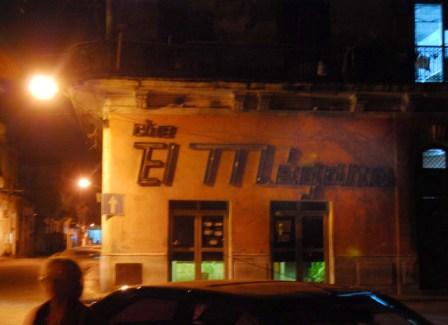El Megano Cinema: A Dark & Safe Place
Yenisel Rodriguez

El Megano is a cinema in a peculiar neighborhood, Centro Havana, and is patronized by marginalized people of all types: indigents, alcoholics, illegal immigrants, homosexuals, transvestites… According to their needs, all of them seek to take advantage of the physical covering afforded by the building. The showing of whatever film is something quite incidental.
The indigents, for example, go in search of a place to take a nap after spending the whole morning selling objects fished out of the garbage. The cinema is a dark and safe place: the basic ingredients for a good snooze.
In the lobby of El Megano, an attendant and a transvestite usher you in. The cleaning attendants will also introduce you to the extra services the cinema offers. One of them is chispa, the cheapest alcoholic drink in the country.
In the darkness, dozens of people form in small groups to talk, sleep or market their wares. Some recline back with their legs raised, while others are curled up in their seats; only a few are actually prostrate on the floor.
The cinema is located 500 yards from the back door of the Capitol Building. Its name reminds one of a documentary of the same name filmed years before the victory of the Revolution. This movie showed the poor conditions in which the coal merchants of the Zapata Marsh worked. For years their images were used to give visual content to pre-revolutionary misery and the abandonment. Fifty years later this name resurges with the same meaning: a forced reunion of Cubans with the demons that we thought were exterminated.
Going to this cinema always reminds me of El Mégano: the haziness of the surroundings, the black and white interior, and the perseverance of its own “actors.” What irony!
I felt like one of its directors. I was an external observer of a gloom-filled reality and it made me want to describe it at least with words.
Perhaps this commentary is another neo-realist El Megano that documents new stories of lost revolutions, as well as points of departure.






A good thumb-nail sketch! I agree, it could be turned into a documentary. Up here in the States a documentary was made about a group of art-house cinastes in Manhattan who spent much of their lives in darkened auditoria. Incidentally, I remember seeing the original documentary to which you refer, about the charcoal-makers of the Zapata Peninsula. I’ve also seen the very first documentary ever made by ICAIC, “P.M.,” a tour of the after-hours dives of Regla on a Saturday night in 1959 or 1960. It was banned by the cultural bureaucrats, but I feel it is a treasure, a priceless part of the national patrimoney, inasmuch as it captured a place in time, and showed people as they actually are, rather than as they are SUPPOSED to be. In 1959, when I was 16, I remember seeing films in a similar theatre, but not in back, but rather in front of the Capitolio, a few blocks further towards the Parque Fraternidad than the Cine Payret. During most of those same years of my mis-spent youth (late 1950’s/early 1960’s), on a Friday or Saturday night I could be found at the Dixie Drive-In, on South Dixie Highway, Miami. I remember having to think fast when my mother asked what film I’d seen and what it was about. I rarely paid attention to such incidentals, only occasionally coming up for air while engaged in other activities!